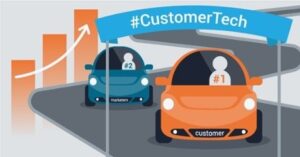Where Does #CustomerTech Fit into Martech? It’s at the Center
January 14, 2019Oh no, you might be saying after reading the headline above. Not another new category in the crowded Martech space, one already filled with thousands of vendors and multiple technologies. Yes, #CustomerTech is a relatively new definition, but it’s here to stay and may well be the future of marketing.
What is #CustomerTech?
Marketing legend Doc Searls defines #CustomerTech as “standard ways for customers to engage with companies at scale — for customers.” So #CustomerTech puts customers first and places them (not marketers) in the driver’s seat. What’s driving the growth of #CustomerTech? Customers want control over their data, and big regulatory changes are giving them more of that control.
What Customers Want Most: Ownership of Their Data
Customers want decision-making power over their data. They want to opt in, to grant marketers permission to reach out to them with messaging that the customer both invites and values, rather than getting spammed by marketers with irrelevant content and being forced to opt-out/unsubscribe. Marketers may talk about “capturing target customers” and “driving them through the funnel,” but unsurprisingly, customers don’t like being viewed as cattle to be corralled and driven through funnels. In fact, customers want to use technology to control how, when, and by whom their data gets used.
This is where #CustomerTech comes in. It flips traditional Martech on its head, because the customer gains the capacity (and tech tools) to decide how they’re marketed to. As a marketer, you can no longer market “at” or “to” customers, but you’ll increasingly need to market “with” customer permission, mediated through #CustomerTech which enables customers to decide the who, what, and when.
Regulatory Changes Support CustomerTech
On May 25, 2018, the new General Data Protection Regulation (GDPR) came into effect across the European Union and for all EU customers, radically altering the way marketers collect, store, and leverage customer data. By the way, just because you don’t do marketing in the EU doesn’t mean you can disregard GDPR. The state of California, for instance, passed a new law quite similar to GDPR. Other U.S. states and nations will likely follow suit, transforming the way companies can market to customers.

Why Marketers Need to Care
The consequences of more customer control over their data and the arrival of new regulations supporting said customer control are simple: (1) more #CustomerTech will emerge to enable customers to “own” their data and control how you market to them, and (2) different approaches and technologies will be needed by marketers based upon gaining customer opt-in/permission and keeping it, as well as supporting compliance with emerging GDPR-like rules. So for marketers, the days of “spray and pray” spamming or consent authorizations buried deep within standard licensing agreements (that nobody reads) are disappearing, much to the delight of customers.
These major changes mean that marketers have no alternative but to take more care in “earning” and retaining customer consent. Marketers need to offer customers value in the content they share, and will need to be hyper-aware that customers always have the right to deny you permission to market to them at any time.
The customer is at the wheel now, and may permit savvy marketers to come along for the ride. But those marketers had better earn their place in the car by offering customers valuable conversations that inform and entertain. New regulations and #CustomerTech are enabling customers to assert control. Marketers don’t have to like it, but it’s the new reality that #CustomerTech helps enable.


